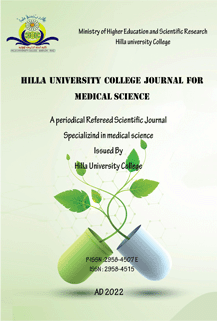Abstract
Amylases are widely used enzymes across various industries such as clinical chemistry, pharmaceuticals, food processing, detergents, textiles, and paper manufacturing. Immobilization can enhance their effectiveness. Nanostructured
materials have become important in many elds, including magnetite nanoparticles (Fe3O4) for immobilizing enzymes.
The study aimed to immobilize alpha-amylase extracted from Bacillus subtilis onto iron oxide nanoparticles coated
with chitosan to compare its catalytic efcacy to its free form. Iron oxide nanoparticles were synthesized and coated. The
substrate underwent amylase introduction with glutaraldehyde, stabilizing formation on chitosan-iron oxide nanoparticles. XRD, FT-IR, FE-SEM, and DLS were used to analyze immobilized amylase on chitosan + iron oxide nanoparticles.
To conclude, we assessed the efcacy of immobilized enzyme versus free enzyme at different pH and temperature
levels. Spectroscopy indicated a strong electrostatic bond between chitosan and Fe3O4 nanoparticles, causing chitosan
to bind onto their surface during alkaline conditions. Alpha-amylase is bonded to the substrate through a Schiff base
bond. Optimal temperature for free and immobilized enzymes is 40 °C, and optimal pH is 7.5. The study found that the
immobilized enzyme was more active than the free enzyme at ideal pH and temperature, and examined their inactivation
in the 40–60 °C range. Free enzymes showed a sharp activity decline, while immobilized enzymes had a slower decline.
This study measured the Vmax and Km values of free and immobilized enzymes. The free enzyme had a Vmax of
61.52 µmol/min.mg and a Km of 0.0082 mg/ml. The immobilized enzyme had a Vmax of 48.43±0.6383 µmol/min.mg and
a Km of 0.0084±0.0016 mg/ml. It also retained 47% activity after 7 cycles. This study shows a new approach to using
enzyme-bound magnetic nanoparticles in various industries like paper and detergent
materials have become important in many elds, including magnetite nanoparticles (Fe3O4) for immobilizing enzymes.
The study aimed to immobilize alpha-amylase extracted from Bacillus subtilis onto iron oxide nanoparticles coated
with chitosan to compare its catalytic efcacy to its free form. Iron oxide nanoparticles were synthesized and coated. The
substrate underwent amylase introduction with glutaraldehyde, stabilizing formation on chitosan-iron oxide nanoparticles. XRD, FT-IR, FE-SEM, and DLS were used to analyze immobilized amylase on chitosan + iron oxide nanoparticles.
To conclude, we assessed the efcacy of immobilized enzyme versus free enzyme at different pH and temperature
levels. Spectroscopy indicated a strong electrostatic bond between chitosan and Fe3O4 nanoparticles, causing chitosan
to bind onto their surface during alkaline conditions. Alpha-amylase is bonded to the substrate through a Schiff base
bond. Optimal temperature for free and immobilized enzymes is 40 °C, and optimal pH is 7.5. The study found that the
immobilized enzyme was more active than the free enzyme at ideal pH and temperature, and examined their inactivation
in the 40–60 °C range. Free enzymes showed a sharp activity decline, while immobilized enzymes had a slower decline.
This study measured the Vmax and Km values of free and immobilized enzymes. The free enzyme had a Vmax of
61.52 µmol/min.mg and a Km of 0.0082 mg/ml. The immobilized enzyme had a Vmax of 48.43±0.6383 µmol/min.mg and
a Km of 0.0084±0.0016 mg/ml. It also retained 47% activity after 7 cycles. This study shows a new approach to using
enzyme-bound magnetic nanoparticles in various industries like paper and detergent
Keywords
Alpha amylase
Chitosan-iron oxide nanoparticles
Immobilitation
